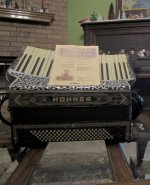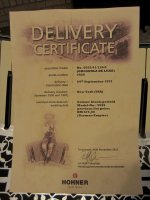noelekal
The Home For Wayward Accordions

Felt almost holiday festive to receive a Hohner factory Delivery Certificate on the curved keyboard model Hohner I acquired back in September. https://www.accordionists.info/threads/oldie-curved-keyboard-hohner-come-to-roost.11293/

Ralf Tritschler was very helpful to advise me in email exchanges. I had initially contacted Hohner's USA office which kindly referred me on to Ralf and he was the one who initiated email contact with me.
Seems I have a Organola De Luxe Model No. 9555 which was shipped to New York on September 4th, 1931. I haven't peeked inside the instrument to this point so don't know if it's a 4/5 reed set or a 4/4. It is described as a No. 9555 /41/120/4.
Using a table found on the internet https://www.paper-dragon.com/1939/exchange.html it would appear to have converted to a cost of $160 US, a tidy sum for the depression year of 1931.
It's a grand old accordion and great fun to play even though I do not play it well. It's amazing how the mechanics of accordion build technology advanced after World War II. Playing this thing is a bit like driving an antique car without power steering and power brakes, no wipers, no heater or air conditioner, and no electric starter.
In playing it I find myself limited to some extent: mostly by the amount of travel required to depress the piano keys, the narrowness of the black keys, slightly wider white keys than those to which I am accustomed, the slide-y bar shift, the more compact 120 bass, and the copious amount of air needed by the reeds. Attempts at a glissando is revealed to be a severe error in judgement as the key travel and the key edges combine to chomp fingers most enthusiastically!
The accordion is tight, as tight as any that I own, but requires a lot of air for sound, hence much "sawing" on the bellows to play when compared to the others on hand here. Since the bellows don't leak when pressure is applied without either venting or playing, I don't know what is going on with the reeds. It just requires more air to give them voice. Perhaps merely a characteristic of the reeds used back in the day.
Part of the playing issue is me I'm sure. I seem to require more practice than I once did to burnish or even retain a measure of what skills I ever had and I haven't devoted the time to this accordion to really familiarize myself with it. I don't intend to give it a lot of playing pressure, but for less complicated pieces it holds a lot of charm.
